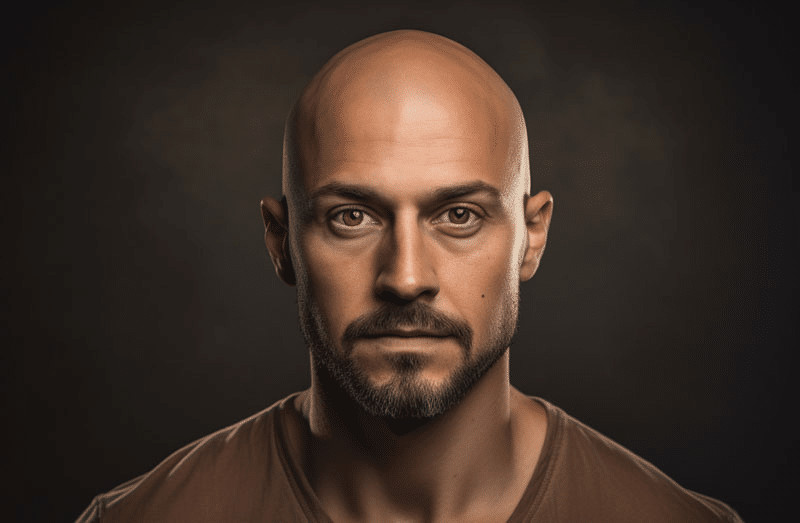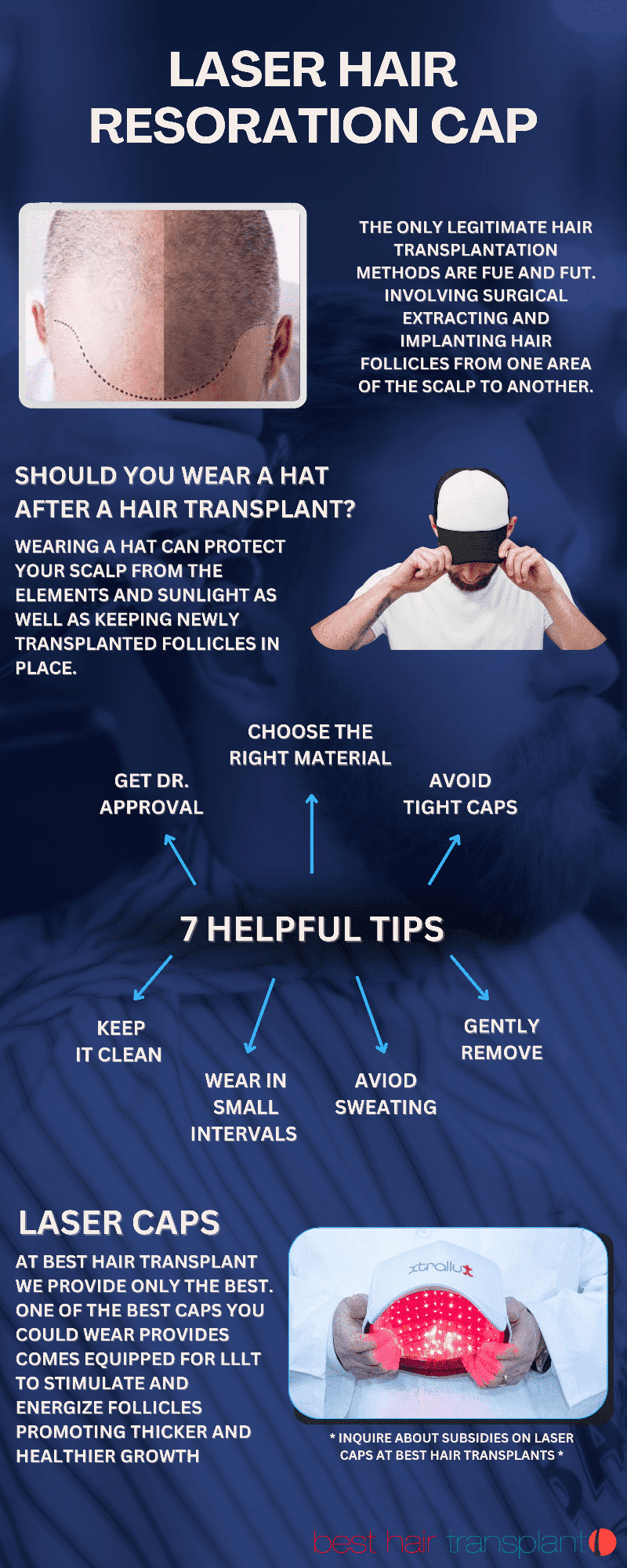A hair transplant hat is a term that has been circulating in the hair restoration industry, but it is actually a myth. This misconception may stem from a lack of understanding about technology or misinformation from other clinics. However, there is no such thing as a hair transplant hat – only actual hair transplant methods like FUE and FUT.
But while these hats don’t exist, there are laser caps for hair loss that have been proven to stimulate and energize hair follicles, reversing miniaturization and promoting thicker, healthier hair growth. At Best Hair Transplant, we recommend using a laser cap low level light therapy hat as part of a long-term hair restoration regimen alongside traditional transplant methods.

The Myth of the “Hair Transplant Hat”
The term “hair transplant hat” has been used frequently in the hair restoration industry, but it is important to dispel this myth and understand the facts. Many people may have heard of this supposed device, but the truth is that it does not exist. The concept of a hair transplant hat may stem from a lack of education about technology or misinformation spread by other clinics for their own benefit.
It is important to understand that the only recognized and legitimate hair transplant methods are FUE (Follicular Unit Extraction) and FUT (Follicular Unit Transplantation). These procedures involve surgically harvesting hair follicles from one area of the scalp and transplanting them to an area with thinning or balding hair. This method has been proven to be effective in restoring natural, permanent hair growth.
Why should I wear a cap after a hair transplant?
After undergoing a hair transplant, wearing a cap may not seem like the most appealing idea. However, it is an important part of the recovery process and can greatly benefit the overall success of your hair restoration journey.
One main reason to wear a cap after a hair transplant is for protection. The scalp area where follicles were harvested and transplanted will be delicate and susceptible to external elements such as sunlight, dust, and bacteria. A cap can provide a barrier of protection against these potential irritants.
Wearing a cap can help reduce swelling in the scalp area after a transplant. It can also help keep the newly transplanted hair follicles in place and prevent any accidental trauma that could disrupt their growth.
Is it safe to wear a cap after a hair transplant?

Many patients who undergo a hair transplant may wonder if it is safe to wear a cap after the procedure. The short answer is yes, it is generally safe to wear a cap after a male and female pattern, but there are some important considerations to keep in mind.
Firstly, it is important to wait until your doctor gives you the green light before wearing a cap. This typically happens around day 3-5 after the procedure. Wearing a cap before this could potentially cause irritation or harm to the newly transplanted follicles.
It is also important to choose the right type of cap. Caps that are too tight or constrictive could cause damage to the scalp and disrupt healing. It is recommended to opt for loose-fitting, breathable caps made from natural materials such as cotton.
7 Tips for Wearing a Hat After a Hair Transplant
Here are some helpful tips for wearing a cap after undergoing a hair transplant:
Doctor’s approval:
Before wearing a cap, it is important to receive approval from your doctor. Following a hair transplant procedure, the scalp will be sensitive and in need of proper care for optimal healing and hair growth. Your doctor will monitor your progress and let you know when it is safe to wear a cap.
Choose the right material:
When selecting a cap to wear after a hair transplant, choose one made from natural materials like cotton or silk. These materials are soft and breathable, allowing for proper airflow to the scalp. Avoid synthetic materials that may cause irritation or trap moisture.

Avoid tight caps:
It is important to avoid tight caps or hats after a hair transplant. These can cause irritation and harm to the scalp, which can disrupt healing and affect the success of your transplant. Opt for loose-fitting caps that are comfortable and won’t put pressure on the scalp.
Keep it clean:
To prevent any potential infection, make sure to keep your cap clean. Wash it regularly and avoid sharing hats with others. This will help maintain the health of your scalp and promote proper healing.
Don’t wear it for extended periods:
While wearing a cap after a hair transplant is beneficial, it is important not to wear it for too long. Extended periods of time can cause excess heat buildup on the scalp, which can hinder proper healing and hair growth.
Avoid sweating under the cap:
Sweating can be a common issue when wearing a cap, especially after a hair transplant. Avoid doing any strenuous activities that can cause excessive sweating while wearing a cap to prevent irritation and potential infection.
Be gentle when removing the cap:
When taking off your cap, be gentle and avoid pulling or tugging on the scalp. This can disrupt healing and potentially dislodge newly transplanted follicles.
What type of hat should I wear after a hair transplant?

Here are some recommended types of hats to wear after a hair transplant:
Laser Caps for Hair Loss
If you are experiencing hair loss, you may have come across the term “laser caps” as a potential solution. Laser treatment for hair loss use low-level laser therapy (LLLT) to stimulate and energize hair follicles, promoting thicker and healthier hair growth.
This non-invasive treatment has gained popularity in recent years and is considered a viable option for those seeking a non-medication approach to treat hair loss. LLLT is believed to work by increasing blood flow to the scalp and providing vital nutrients and oxygen to hair follicles.
Fedora Hats: A Timeless Classic
The fedora hat has been a staple in fashion for decades, making it a timeless classic that continues to be worn by both men and women today. It first gained popularity in the early 20th century and has since become a symbol of sophistication and style.
Originally designed as a practical accessory for men, the fedora hat was created to protect their heads from the elements, particularly during outdoor activities such as horseback riding or hunting. However, it quickly evolved into a fashion statement and became associated with iconic figures like Frank Sinatra and Humphrey Bogart.
Wide-Brimmed Hats for Sun Protection:
One of the main reasons to wear a cap after a hair transplant is for protection against external elements, particularly sunlight. As the scalp recovers from the procedure, it may be more susceptible to sun damage and UV rays, making it important to shield it from direct exposure. This is where wide-brimmed hats come in.
Wide-brimmed hats offer ample coverage to protect the scalp, face, and neck from harmful UV rays. They are especially beneficial for those who have undergone a hair transplant on their face or neck and need extra protection during the healing process.
Baseball Caps for Casual Wear:
Baseball caps are a popular choice for casual wear, and they can also be a good option to wear after a hair transplant. These caps have a curved brim and a structured crown, making them perfect for shielding the scalp from sunlight while maintaining a sporty and relaxed look.
One of the main advantages of baseball caps is their versatility. They come in various materials and designs, so you can find one that suits your personal style. They also offer a comfortable fit with adjustable straps at the back, allowing for easy adjustments to accommodate swelling or bandages after a hair transplant procedure.
We Recommend Using a Laser Cap After a Hair Transplant

While there are many types of hats to choose from, we highly recommend using a laser cap after a hair transplant for optimal results. Laser caps provide targeted treatment to the scalp and promote healthy hair growth without the need for medication or invasive procedures.
With regular use, laser light can help maintain the results of your hair transplant surgery
and prevent further hair loss in the future. They are also convenient to use, as they can be worn at home during daily activities. Consult with your doctor before incorporating a laser cap into your post-transplant care routine to ensure it is safe for your specific case.
When is it safe to wash my hair after a hair transplant?
After undergoing a hair transplant procedure, one might be eager to wash their hair and return to their regular hair care routine. However, it is important to follow the post-operative instructions provided by your doctor to ensure proper healing and successful results. So when exactly is it safe to wash your newly transplanted hair?
Typically, doctors recommend waiting at least 48 hours before washing your hair after a hair transplant. This allows the transplanted follicles to set and minimizes the risk of infection or damaging them in any way. However, this time frame may vary depending on the specific technique used during the procedure, as well as individual healing factors. It is important to consult with your doctor for their specific recommendations.
How should I wear a hat after a hair transplant?
After undergoing a hair transplant, it is important to take extra care when wearing a hat to ensure proper healing and successful results. Here are some tips on how to wear a hat after a hair transplant:

Choose the right material – As mentioned earlier, opting for hats made from natural materials such as cotton or silk is recommended. These materials allow for proper airflow to the scalps and are less likely to cause irritation or harm.
Avoid tight-fitting hats – Avoid wearing hats that are too tight, as they can put pressure on the scalp and disrupt healing. Choose loose-fitting hats that provide enough room for your scalp to breathe and heal properly.
Be mindful of hat accessories – Some hats may come with stiff tags or labels on the inside, which can cause irritation to the scalp. Make sure to remove or cover these accessories before wearing the hat to avoid discomfort.
Use a protective barrier – If you choose to wear a hat during the initial healing period, it is advisable to use a protective barrier between your scalp and the hat’s material. This could be in the form of a soft bandage, scarf, or even a cotton cloth. This barrier will help prevent any friction or irritation on the scalp while wearing the hat.
Don’t wear a hat for extended periods – It is important to give your scalp some time to breathe and heal without being covered by a hat for long periods. If possible, try to limit how often you wear a hat during the initial healing period. This will also help prevent any potential damage to the newly transplanted follicles.
Hair transplants and sun exposure
When it comes to recovering from a hair transplant, protecting your scalp from sun exposure is crucial. The scalp is a sensitive area that has just undergone a surgical procedure, and it needs time to heal properly. Exposure to direct sunlight can cause significant harm and potentially affect the success of your hair transplant.
One of the main concerns with sun exposure after a hair transplant is the risk of UV rays damaging the newly transplanted follicles. These UV rays can cause damage to the delicate hair follicles, leading to poor growth or even complete failure of the transplant. Additionally, excessive sun exposure can also cause scarring on the scalp, which can affect hair growth in the future.
To avoid these potential risks, it is crucial to protect your scalp from sun exposure after a hair transplant. This can be done by wearing hats or using other forms of sun protection such as umbrellas or scarves when outdoors. It is also important to limit direct sunlight exposure during peak hours, typically between 10 am to 4 pm.
How Long After A Hair Transplant Can I Wear A Hat?
After undergoing a hair transplant, many individuals may wonder when it is safe to start wearing hats again. While hats can be used as a fashion statement or for practical reasons, such as protecting the scalp from external elements, they can also potentially impact the healing process and results of a hair transplant. Therefore, it is crucial to understand how long after a you should wait to wear a hat.
As mentioned earlier, doctors typically recommend waiting at least 48 hours before wearing a hat after a hair transplant. This initial period allows the transplanted follicles to settle and minimizes the risk of infection or damage. However, this time frame may vary depending on the specific technique used during the procedure, as well as individual healing factors.
In most cases, doctors will advise patients to avoid wearing hats for at least the first week after a hair transplant. This is because the scalp is still in the healing process and may be sensitive or prone to infection during this time. After the initial week, it is safe to start gradually incorporating hats back into your routine, but with caution.
How to look after your hair after hair transplantation surgery?

Proper aftercare is crucial for the success of a hair transplant procedure. Here are some general tips on how to look after your hair after hair transplantation surgery:
Follow your doctor’s instructions:
Your doctor will provide specific post-operative instructions that you should follow carefully. This may include using medicated shampoos, avoiding certain hair products, and following a gentle hair count routine. Make sure to adhere to these instructions to ensure proper healing and successful results.
Avoid strenuous activities:
During the initial healing period, it is important to avoid any strenuous activities that may cause excessive sweating or impact the scalp in any way. This includes physical exercise, heavy lifting, and even bending over for extended periods.
Do not scratch or pick at scabs:
After a hair transplant, it is common to experience some scabbing on the scalp. It is important not to scratch or pick at these scabs as they can potentially damage the newly transplanted follicles and disrupt the healing process.
Follow a healthy diet:
A healthy diet can promote hair growth and overall wellness. After a hair transplant, it is important to follow a balanced diet rich in vitamins and nutrients to support proper healing and strong hair growth.
Attend follow-up appointments:
Make sure to attend any scheduled follow-up appointments with your doctor after the hair transplant. These appointments are crucial for monitoring the healing process and addressing any concerns or issues that may arise.
Are there other ways to conceal the scalp after a hair transplant?
If you are not comfortable wearing hats or are looking for alternative ways to conceal your scalp after a hair transplant, there are other options available. These include:
Scarves or head wraps – Scarves or head wraps can provide coverage for the human scalp hair mediated while also adding a fashionable touch to your look. They come in various styles and materials, allowing you to change up your hairstyle while still protecting your scalp.
Toppik or other hair fibers – Toppik and other similar hair fibers can be used to cover any thinning areas or scabs on the scalp after a hair transplant. These fibers cling to existing hairs, creating the appearance of fuller, thicker hair.

FAQs:
What is a Hair Loss Hair Transplant Hat?
A Hair Transplant Hat is a specialized medical device designed to aid in post-hair transplant recovery and promote hair regrowth. It typically incorporates low-level light therapy (LLLT) technology that emits visible red light lasers which help with hair loss. Low Level Light Therapy is an alternative for other hair loss treatments like hair regrowth surgery.
How does a Hair Transplant Hat work in the context of hair restoration?
A Hair Transplant Hat utilizes low-level light therapy to deliver visible red light laser to the scalp. This specific wavelength of light is thought to energize dormant hair follicles, extend the anagen (growth) phase of hair, and reduce hair shedding. This non-invasive approach can be beneficial for individuals experiencing male androgenetic alopecia (male pattern baldness) or female pattern hair loss.
Are Hair Transplant Hats a standalone solution for hair loss or used in combination with other hair loss treatments?
Hair Transplant Hats are often used in conjunction with other hair loss treatments to maximize results. While they can help with hair regrowth and maintenance, they are not typically the sole solution for severe hair loss.

